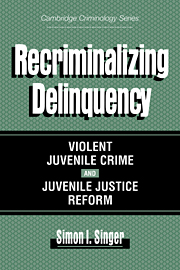Book contents
- Frontmatter
- Contents
- List of Figures and Tables
- Acknowledgments
- Introduction
- 1 Recriminalizing Violent Juvenile Crime
- 2 Taking Stock of Juvenile Justice Reforms
- 3 Recriminalization on the Move and Its Legal Rules
- 4 Contextual and Legal Reasons for Identifying Juveniles as Criminal Offenders
- 5 The Case Processing of Juvenile Offenders: From Arrest to Disposition
- 6 Recriminalization and Organizing for Deterrence
- 7 Convicted Juvenile Offenders in a Maximum Security Institution
- 8 Concluding “Real” Reasons for Recriminalizing Delinquency
- Appendixes
- Notes
- References
- Index
2 - Taking Stock of Juvenile Justice Reforms
Published online by Cambridge University Press: 29 September 2009
- Frontmatter
- Contents
- List of Figures and Tables
- Acknowledgments
- Introduction
- 1 Recriminalizing Violent Juvenile Crime
- 2 Taking Stock of Juvenile Justice Reforms
- 3 Recriminalization on the Move and Its Legal Rules
- 4 Contextual and Legal Reasons for Identifying Juveniles as Criminal Offenders
- 5 The Case Processing of Juvenile Offenders: From Arrest to Disposition
- 6 Recriminalization and Organizing for Deterrence
- 7 Convicted Juvenile Offenders in a Maximum Security Institution
- 8 Concluding “Real” Reasons for Recriminalizing Delinquency
- Appendixes
- Notes
- References
- Index
Summary
part of the reason for recriminalization in New York and in other states is contained in a long history of earlier juvenile justice reforms. A history of reforms takes us beyond Willie Bosket and a governor's election campaign and helps us to understand the specific timing and content of waiver legislation. By moving away from the immediate sources of crisis, we can more accurately see the emergence of the political and organizational concerns and interests that paved the way toward recriminalization. The sources of legal change are in part internal in that each new generation of reforms is directly linked to a set of assumptions inherited from the previous generation of reformers. The assumptions of prior generations were modified and refitted to address the local concerns and interests of each successive generation of reformers (Sutton 1988: 5).
In this chapter I take stock of a history of juvenile justice reforms to see how the assumptions of officials in prior generations set into motion systems of juvenile justice. I seek to understand, not entirely to explain, the social and legal circumstances that produced loosely coupled systems of juvenile justice with diverse sets of legal avenues and legal labels. I highlight crisis, beliefs, and administrative concerns in the system's emerging ability to identify and classify juveniles as delinquents, status offenders, and juvenile offenders.
- Type
- Chapter
- Information
- Recriminalizing DelinquencyViolent Juvenile Crime and Juvenile Justice Reform, pp. 24 - 45Publisher: Cambridge University PressPrint publication year: 1996



